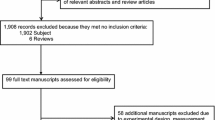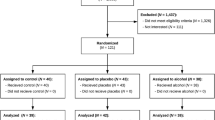Abstract
The interaction of sexual fear and acute alcohol intoxication on the likelihood of risky sexual behavior was explored. Participants (Ps; N = 115) completed a measure of sexual fears and were randomly assigned to no-, low-, or high-dose alcohol conditions. Ps then read an eroticized vignette, where they were the protagonist, and rated their likelihood of sex with a new partner when no condom was available. Controlling for gender and social desirability, compared to sober Ps, highly intoxicated Ps indicated that they were more likely to engage in risky sexual behaviors. Sexual fear was modestly negatively related to risky sex likelihood among sober or mildly intoxicated Ps but strongly positively related to risky sex likelihood among highly intoxicated Ps. Findings underscore the notion that alcohol affects different types of individuals differently and indicate that alcohol may foster sexual risk-taking, in part, by attenuating or counteracting fear or anxiety.

Similar content being viewed by others
Notes
Data were analyzed both from the full sample and from the subset of self-identified exclusive heterosexuals. The pattern of results was identical.
Please note that drinking in the vignette was not a manipulation independent of participant’s drinking; rather, it was an extension of the primary independent variable, alcohol intoxication. We labeled the drinks in the vignette (alcohol versus soft drinks) to be consistent with participants’ alcohol consumption in the laboratory to facilitate their ability to project themselves into the vignette. We did not cross participants’ drinking with protagonist’s drinking. Doing so could have interfered with participants’ ability to take perspective in the vignette, particularly highly intoxicated participants, introducing a potentially serious confound.
Sexual aversion in the present sample was comparable to levels reported by Katz et al. (1993) in undergraduates sampled in 1988, 1991, and 1992 (means of 1.75, 1.80, and 1.88, respectively, on a 4-point scale). In the present study and in Katz’ samples, means were approximately 25% below the midpoint of the scale.
References
Abbey, A., Saenz, C., & Buck, P. O. (2005). The cumulative effects of acute alcohol consumption, individual differences and situational perceptions on sexual decision making. Journal of Studies on Alcohol, 66, 82–90.
Agocha, V. B., & Cooper, M. L. (1999). Risk perceptions and safer-sex intentions: Does a partner's physical attractiveness undermine the use of risk-relevant information? Personality and Social Psychology Bulletin, 25, 746–759.
Catania, J. A., Kegeles, S. M., & Coates, T. J. (1990). Towards and understanding of risk behavior: An AIDS risk reduction model (ARRM). Health Education Quarterly, 17, 53–72.
Centers for Disease Control and Prevention (2000). Tracking the hidden epidemics: Trends in STDs in the United States, 2000. Atlanta, GA: Centers for Disease Control and Prevention.
Chambers, K. B., & Rew, L. (2003). Safer sexual decision making in adolescent women: Perspectives from the conflict theory of decision-making. Issues in Comprehensive Pediatric Nursing, 26, 129–143.
Comeau, N., Stewart, S. H., & Loba, P. (2001). The relations of trait anxiety, anxiety sensitivity, and sensation seeking to adolescents’ motivations for alcohol, cigarette, and marijuana use. Addictive Behaviors, 26, 803–825.
Cooper, M. L. (2002). Alcohol use and risky sexual behavior among college students and youth: Evaluating the evidence. Journal of Studies on Alcohol, 14, 101–117.
Crowne, D. P., & Marlow, D. (1960). A new scale of social desirability independent of psychopathology. Journal of Consulting Psychology, 24, 349–354.
Davis, K. C., George, W. H., Norris, J., Kajumulo, K. F., Stoner, S. A., Schacht, R. L. et al. (2004). The influence of alcohol expectancies on sexual behavior in risky situations. Poster presented at the annual meeting of the Research Society on Alcoholism, Vancouver, Canada.
Fisher, W. A., Byrne, D., White, L. A., & Kelley, K. (1988). Erotophobia–erotophilia as a dimension of personality. Journal of Sex Research, 25, 123–151.
Fromme, K., D’Amico, E. J., & Katz, E. C. (1999). Intoxicated sexual risk-taking: An expectancy or cognitive impairment explanation? Journal of Studies on Alcohol, 60, 54–63.
Geer, J. H. (1965). The development of a scale for measuring fear. Behaviour Research and Therapy, 3, 45–53.
George, W. H., & Stoner, S. A. (2000). Understanding acute alcohol effects on sexual behavior. Annual Review of Sex Research, 11, 92–124.
Giancola, P. R., & Zeichner, A. (1997). The biphasic effects of alcohol on human physical aggression. Journal of Abnormal Psychology, 106, 598–607.
Gordon, C. M., Carey, M. P., & Carey, K. B. (1997). Effects of a drinking event on behavioral skills and condom attitudes in men: Implications for HIV risk from a controlled experiment. Health Psychology, 16, 490–495.
Greeley, J., & Oei, T. (1999). Alcohol and tension reduction. In K. E. Leonard, H. T. Blane (Eds.), Psychological theories of drinking and alcoholism (2nd ed., pp. 14–53). New York: Guilford Press.
Halpern-Felsher, B. L., Millstein, S. G., & Ellen, J. M. (1996). Relationship of alcohol use and risky sexual behavior: A review and analysis of findings. Journal of Adolescent Health, 19, 331–336.
Hirshfield, S., Remien, R. H., Humberstone, M., Walavalkar, I., & Chiasson, M. A. (2004). Substance use and high-risk sex among men who have sex with men: A national online study in the USA. AIDS Care, 16, 1036–1047.
Katz, R. C., & Jardine, D. (1999). The relationship between worry, sexual aversion, and low sexual desire. Journal of Sex and Marital Therapy, 25, 293–296.
Katz, R. C., Frazer, N., & Wilson, L. (1993). Sexual fears are increasing. Psychological Reports, 73, 476–478.
Katz, R. C., Gipson, M., & Turner, S. (1992). Brief report: Findings on the sexual aversion scale. Journal of Sex and Marital Therapy, 18, 141–146.
Katz, R. C., Gipson, M. T., Kearl, A., & Kriskovich, M. (1989). Assessing sexual aversion in college students: The sexual aversion scale. Journal of Sex and Marital Therapy, 15, 135–140.
LaBrie, J., Earlywine, M., Schiffman, J., Pedersen, E., & Marriot, C. (2005). Effects of alcohol, expectancies, and partner type on condom use in college males: Event-level analyses. Journal of Sex Research, 42, 259–266.
Leigh, B. C. (2002). Alcohol and condom use: A meta-analysis of event-level studies. Sexually Transmitted Diseases, 29, 476–482.
Leigh, B. C., & Stall, R. (1993). Substance use and risky sexual behavior for exposure to HIV. American Psychologist, 48, 1035–1045.
MacDonald, T. K., MacDonald, G., Zanna, M. P., & Fong, G. T. (2000). Alcohol, sexual arousal, and intentions to use condoms in young men: Applying alcohol myopia theory to risky sexual behavior. Health Psychology, 19, 290–298.
Maisto, S. A., Carey, M. P., Carey, K. B., Gordon, C. M., & Schum, J. L. (2004a). Effects of alcohol and expectancies on HIV-related risk perception and behavioral skills in heterosexual women. Experimental and Clinical Psychopharmacology, 12, 288–297.
Maisto, S. A., Carey, M. P., Carey, K. B., Gordon, C. M., Schum, J. L., & Lynch, K. G. (2004b). The relationship between alcohol and individual differences variables on attitudes and behavioral skills relevant to sexual health among heterosexual young adult men. Archives of Sexual Behavior, 33, 571–584.
Mayfield, D., McLeod, G., & Hall, P. (1974). The CAGE questionnaire: Validation of a new alcoholism screening instrument. American Journal of Psychiatry, 131, 1121–1123.
Meyer, T. J., Miller, M. L., Metzger, R. L., & Borkovec, T. D. (1990). Development and validation of the Penn State Worry Questionnaire. Behaviour Research and Therapy, 28, 487–496.
Monahan, J. L., Murphy, S. T., & Miller, L. C. (1999). When women imbibe: Alcohol and the illusory control of HIV risk. Psychology of Women Quarterly, 23, 643–651.
Norris, J., George, W. H., Stoner, S. A., Masters, N. T., Zawacki, T., & Davis, K. C. (in press). Women’s responses to sexual aggression: The effects of childhood trauma, alcohol, and prior relationship. Experimental and Clinical Psychopharmacology.
Spielberger, C. D., Gorsuch, R. L., & Lushene, R. E. (1970). Manual for the state-trait anxiety inventory. Palo Alto, CA: Consulting Psychologists Press.
Steele, C. M., & Josephs, R. A. (1990). Alcohol myopia: Its prized and dangerous effects. American Psychologist, 45, 921–933.
Steele, C. M., & Southwick, L. (1985). Alcohol and social behavior I: The psychology of drunken excess. Journal of Personality and Social Psychology, 48, 18–34.
UNAIDS (2004). 2004 Report on the global AIDS epidemic. Geneva: UNAIDS.
Weinhardt, L. S., & Carey, M. P. (2000). Does alcohol lead to sexual risk behavior? Findings from event-level research. Annual Review of Sex Research, 11, 125–157.
Yarnall, K. S. H., McBride, C. M., Lyna, P., Fish, L. J., Civic, D., Grothaus, L., & Scholes, D. (2003). Factors associated with condom use among at-risk women students and nonstudents seen in managed care. Preventive Medicine, 37, 163–170.
Acknowledgments
Conduct of this research was supported in part by a Sexuality Research Fellowship awarded to the Susan A. Stoner from the Social Science Research Council with funding from the Ford Foundation, by a grant from the Alcohol and Drug Abuse Institute of the University of Washington to William H. George, and by a grant from the National Institute on Alcohol Abuse and Alcoholism (AA13565) to William H. George. Portions of the findings were presented at the 2003 meeting of the Society for the Scientific Study of Sexuality in San Antonio, TX.
Author information
Authors and Affiliations
Corresponding author
Appendix
Appendix
Sexual Desire and Decision-Making Dependent Measures
Section 1 | |
1. | How much do you desire to have sex with [Ellen]/[Dan]* |
2. | How much do you wish you had a condom |
3. | How likely are you to ask [Ellen]/[Dan] if [she]/[he] has a condom |
4. | How likely are you to have sex with [Ellen]/[Dan] even if [she]/[he] does not have a condom |
Section 2 | |
5. | How much do you desire [Ellen]/[Dan] to perform oral sex on you* |
6. | How likely are you to allow [Ellen]/[Dan] to perform oral sex on you |
7. | How much do you desire to perform oral sex on [Ellen]/[Dan]* |
8. | How likely are you to perform oral sex on [Ellen]/[Dan] |
9. | How much do you desire to rub your [penis]/[clitoris] against [Ellen]/[Dan]’s [clitoris]/[penis]* |
10. | How likely are you to rub your [penis]/[clitoris] against [Ellen]/[Dan]’s [clitoris]/[penis] |
Section 3 | |
11. | How much do you desire to [put your penis]/[allow Dan to put his penis] inside of [Ellen]/[you]* |
12. | How likely are you to [put your penis]/[allow Dan to put his penis] inside of [Ellen]/[you] |
13. | How much do you desire to relax and let [Ellen]/[Dan] decide how far to go* |
14. | How likely are you to relax and let [Ellen]/[Dan] decide how far to go |
Rights and permissions
About this article
Cite this article
Stoner, S.A., George, W.H., Peters, L.M. et al. Liquid Courage: Alcohol Fosters Risky Sexual Decision-Making in Individuals with Sexual Fears. AIDS Behav 11, 227–237 (2007). https://doi.org/10.1007/s10461-006-9137-z
Published:
Issue Date:
DOI: https://doi.org/10.1007/s10461-006-9137-z




